2. 城市水资源与水环境国家重点实验室(哈尔滨工业大学),国际持久性有 毒物质联合研究中心,哈尔滨 150090;
3. 哈尔滨工业大学 极地研究院,北极生态与环境国际联合研究中心,哈尔滨 150090
2. International Joint Research Center for Persistent Toxic Substances, State Key Laboratory of Urban Water Resource and Environment (Harbin Institute of Technology), Harbin 150090, China;
3. International Joint Research Center for Arctic Environment and Ecosystem, Polar Academy, Harbin Institute of Technology, Harbin 150090, China
多溴联苯醚(PBDEs)是一种被广泛使用的商用阻燃剂,由于具有持久性、毒性和长距离迁移的特性,其商用五溴、八溴和十溴产品已被斯德哥尔摩公约列入消除名册[1]。与其他持久性有机污染(POPs)一样,即使被禁止使用,PBDEs也会数十年甚至数百年残留在环境介质中,持续对人类健康造成潜在威胁[2]。
大气环境是污染物远距离传输和对人体暴露的一个重要途径。研究表明,PBDEs可以以气态和颗粒态的形式广泛存在于全球的大气环境,如城市、乡村,甚至两极地区[3-4]。气态和颗粒态的PBDEs均可通过呼吸作用和皮肤暴露的方式进入人体,进而对人体的健康造成危害[5-7]。与气态PBDEs不同,颗粒态PBDEs在大气中的分布是非均一的,较多地分布在1 μm左右或者样品采集过程中获得的最小粒径区间[8-11],因此,颗粒态PBDEs对人体的危害机制十分复杂。
目前, 对颗粒态PBDEs的健康风险评估主要依靠监测数据,但获取颗粒物的监测数据是非常耗费人力和财力的过程,并且依赖于采样设备和监测技术。目前只有作者之前的一篇研究提出了一个预测粒径影响下PBDEs呼吸暴露摄入剂量的可靠方法[12]。由于评价皮肤暴露需要考虑颗粒物中PBDEs通过皮肤亲脂界面和皮肤组织多层阻力的过程[13-14],尚没有研究给出可预测考虑到粒径影响下PBDEs皮肤暴露剂量的方法。本研究首先评估了哈尔滨大气中PBDEs的人体经皮肤每日摄入剂量,利用作者所建立的多粒径PBDEs气/粒分配公式,预测粒径影响下PBDEs经皮肤每日剂量,并与监测数据的皮肤摄入量对比,评估预测的可靠性。
1 皮肤暴露预测 1.1 皮肤暴露模型人体经由皮肤摄入大气中颗粒态PBDEs(IP)和气态PBDEs(IG)每日摄入剂量分别可由式(1)和(2)计算[13-14]:
| $ I_{\mathrm{P}}=\sum\left(\rho_{\mathrm{p} i} \times k_{\mathrm{p}, \mathrm{p} i}\right) \times A_{\mathrm{S}} \times f \times t $ | (1) |
| $ I_{\mathrm{G}}=\rho_{\mathrm{G}} \times k_{\mathrm{p}, \mathrm{g}} \times A_{\mathrm{S}} \times f \times t $ | (2) |
式中:ρPi为大气颗粒态PBDEs在粒径区间i颗粒物中的质量浓度(pg/m3),ρG为大气中气态PBDEs的质量浓度(pg/m3)(见Hu等[12]),AS为人体皮肤表面积(m2),f为人体皮肤暴露在空气中的比例(只考虑头部和手部,AS×f=0.2 m2)[15],t为每日暴露时长(假设为8 h/d)。kp, pi和kp, g分别为粒径区间i颗粒态PBDEs和气态PBDEs的经皮渗透系数,分别由式(3)和(4)计算[14, 16]:
| $ k_{\mathrm{p}, \mathrm{p} i}=1 /\left[\frac{2.6+\left(M_{\mathrm{W}}^{0.5} \times k_{\mathrm{p}, \mathrm{cw}}\right)}{0.026(R T / H) \times k_{\mathrm{p}, \mathrm{cw}}}+\frac{1}{v_{\mathrm{d}(\mathrm{p} i)}}\right] $ | (3) |
| $ k_{\mathrm{p}, \mathrm{g}}=1 /\left[\frac{2.6+\left(M_{\mathrm{W}}^{0.5} \times k_{\mathrm{p}, \mathrm{cw}}\right)}{0.026(R T / H) \times k_{\mathrm{p}, \mathrm{cw}}}+\frac{1}{v_{\mathrm{d}(\mathrm{g})}}\right] $ | (4) |
式中:PBDEs相关参数见表 1。MW为PBDEs摩尔质量(g/mol),kp, cw为当皮肤表面覆盖水时PBDEs穿透皮肤角质层的渗透系数(见表 1,cm/h), R为理想气体常数(8.314 Pa·m3/(K·mol)),T为皮肤温度(305 K),H为PBDEs亨利系数(Pa·m3/mol),vd(pi)和vd(g)分别为粒径区间i颗粒态PBDEs(大于3.2 μm、0.56~3.2 μm、0.1~0.56 μm和0.56~0.1 μm粒径区间vd(pi)分别为1.65、0.015 7、0.037 2和0.603 m/h)和气态PBDEs的传质速率(6 m/h)[25]。
| 表 1 8种PBDEs摩尔质量(MW)、亨利常数(H)、角质层渗透系数(kp, cw)及克劳修斯克拉佩龙方程系数(A和B) Tab. 1 Mole weight (MW), Henry constant (H), permeability coefficient through the stratum corneum (kp, cw), and Clausius-Clapeyron coefficients (A and B) of eight PBDE congeners |
多粒径气/粒分配公式可通过气态PBDEs质量浓度预测不同粒径区间颗粒物中PBDEs质量浓度。现有平衡态下的预测公式[17-18]:
| $ \log K_{\mathrm{PE} i}=\log K_{\mathrm{OA}}+\log f_{\mathrm{OM} i}-11.91 $ | (5) |
作者近期得到的恒稳态预测公式[12]:
| $ \log K_{\mathrm{PS}-\mathrm{OM} i}=\log K_{\mathrm{PS}}+\Delta \log K_{\mathrm{POM} i} $ | (6a) |
| $ \Delta \log K_{\rm {POM } {\mathit{i}}}=0.52 \log f_{\rm {OM } {\mathit{i}}}+0.56 $ | (6b) |
式中:log KPEi和log KPS-OMi分别为平衡态和恒稳态下粒径区间i中PBDEs的气/粒分配配额,KOA为正辛醇- 空气分配系数(log KOA=A+B/T, A和B为克劳修斯克拉佩龙方程系数,见表 1; T为大气温度,K),fOMi为粒径区间i颗粒物有机质质量分数,Δlog KPOMi为各粒径区间log KPSi与log KPS的偏离量,log KPS为全颗粒态(总悬浮颗粒物,TSP)PBDEs的气/粒分配配额[19], 即
| $ \log K_{\mathrm{PS}}=\log K_{\mathrm{OA}}+\log f_{\mathrm{OM}}-11.91+\log \alpha $ | (7) |
式中:log α=-log(1+2.09/C×10-10 fOM KOA),fOM为TSP有机质质量分数(=0.1),C为常数(=5)。
2 结果讨论 2.1 哈尔滨大气中PBDEs人体每日摄入量使用Hu等[12]报道的哈尔滨2017—2018年11个粒径区间(0.056~0.1、0.1~0.18、0.18~0.32、0.32~0.56、0.56~1、1~1.8、1.8~3.2、3.2~5.6、5.6~10、10~18和>18 μm)颗粒态PBDEs以及气态PBDEs的质量浓度数据,评估哈尔滨大气中PBDEs的人体经皮肤每日摄入量。如图 1所示,哈尔滨全年大气环境中PBDEs的人体经皮肤日摄入量为71.6 pg/d,其中气态PBDEs日摄入量为38.8 pg/d,略高于颗粒态(32.8 pg/d)。BDE-209是人体经皮肤摄入的主要单体,其每日摄入量为66.2 pg/d,占8种PBDEs摄入量的91.3%。此外,8种PBDEs均表现为气态摄入量高于颗粒态,且颗粒态PBDEs摄入量与气态PBDEs摄入量比例随相对分子质量的增大而增高,最小为BDE-17(0.09),最大为BDE-209(0.92)。由于相对分子质量较大的PBDEs单体亲脂性高,且与皮肤油脂性表面亲和力较强[21],在空气中颗粒态PBDEs所占比例较大[3],经皮肤摄入的颗粒态质量浓度也较高。
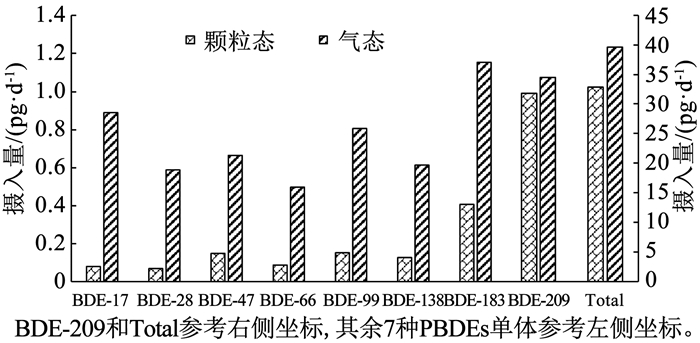
|
图 1 8种颗粒态和气态PBDEs的人体经皮肤每日摄入量 Fig. 1 Daily dermal intakes of eight particulate and gaseous PBDEs |
如图 2所示,供暖期(10月15日—次年4月15日)人体经皮肤每日摄入PBDEs量为118 pg/d(颗粒态56.6 pg/d,气态61.6 pg/d),远高于非供暖期(41.7 pg/d,颗粒态9.99 pg/d,气态31.8 pg/d),说明供暖期大气环境中PBDEs对人体危害更为严重。值的注意的是,PBDEs多数是以气态的形式从被添加产品中挥发至大气环境中的[22-23],供暖期锅炉燃烧并不会向大气环境中释放更多的PBDEs。但是,供暖产生的颗粒物造成供暖期大气环境中颗粒物质量浓度大大升高,为气态PBDEs的吸附(被颗粒态吸收)提供了条件。根据PBDEs气/粒分配理论,温度降低时,气态PBDEs更容易被大气颗粒物吸收[19, 24]。供暖期温度较低,且空气中颗粒物质量浓度较高,大量的气态PBDEs被颗粒物所吸收。此外,供暖期哈尔滨室内温度并不低于非供暖期,气态PBDEs的源释放较供暖期并未减弱,可能会更强,更多的气态PBDEs挥发至大气环境中,绝大多数被大气颗粒物所吸收,并且由于供暖期室外温度较低,颗粒物吸收气态PBDEs能力较非供暖期更强,进而造成供暖期PBDEs人体经皮肤摄入量高于供暖期。从图 2中亦可得到,尽管供暖期和非供暖期气态PBDEs人体经皮肤每日摄入量均高于颗粒态PBDEs,但非供暖期气态PBDEs摄入量是颗粒态PBDEs的3.18倍,而供暖期该比例仅为1.09,供暖期颗粒态PBDEs经皮肤摄入量较非供暖期大大增高,解释了供暖期大气PBDEs人体经皮肤摄入量较高是由颗粒物质量浓度较高引起的。
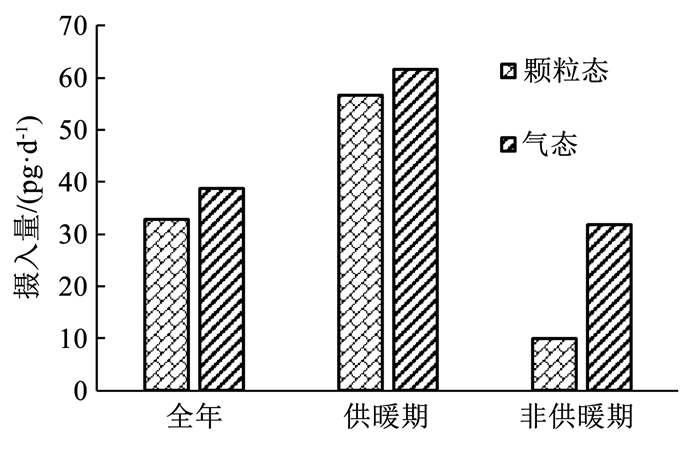
|
图 2 哈尔滨全年、供暖期和非供暖期颗粒态和气态PBDEs的人体经皮肤每日摄入量 Fig. 2 Daily dermal intakes of particulate and gaseous PBDEs in Harbin throughout the year, and during heating and non-heating periods |
大气中颗粒态PBDEs粒径分布较为广泛,且非均一分布,因此,对颗粒态PBDEs人体经皮肤摄入量的评估较为复杂[14, 25]。如图 3所示,粒径区间大于3.2 μm的颗粒态PBDEs的人体经皮肤摄入量,占总颗粒态PBDEs人体经皮肤摄入量的比例最大(93.7%),其次是0.056~ 0.1 μm(3.93 %)、0.1~0.56 μm(1.58%)和0.56~3.2 μm(0.81%),且8种PBDEs人体经皮肤摄入量均表现为相同的粒径分布规律。由式(1)和(3)可知,各粒径区间PBDEs皮肤摄入量差异主要是由vd(pi)和ρPi粒径分布引起的,各粒径区间颗粒态PBDEs的经皮肤摄入量分布与vd(pi)在各粒径区间分布规律一致,而各粒径区间ρPi大小则为大于3.2 μm>0.56~3.2 μm>0.1~0.56 μm>0.056~0.1 μm,说明vd(pi)对不同粒径区间PBDEs皮肤摄入量影响是主要的。
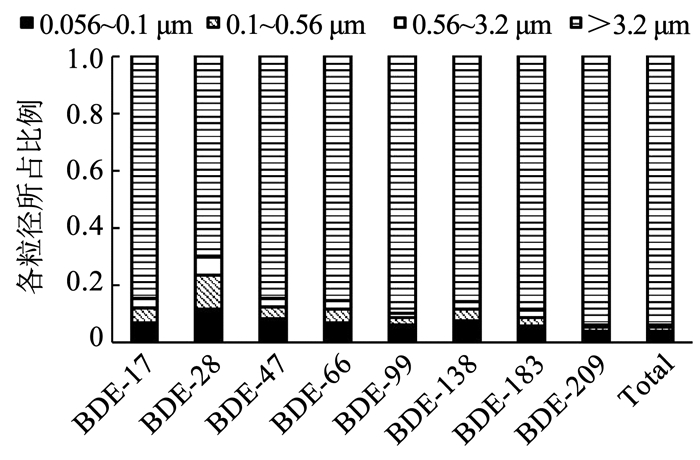
|
图 3 8种PBDEs人体经皮肤每日摄入量的粒径分布 Fig. 3 Particle size-distribution of daily dermal intakes for eight PBDEs |
受PBDEs粒径分布的影响,颗粒态PBDEs的人体经皮肤摄入量与气态PBDEs相比更加难以评估。与气态PBDEs相比,获取颗粒态PBDEs的监测数据需要精密度更高的样品采集设备和灵敏度更高的检测设备。因此,制定预测人体经皮肤摄入颗粒态PBDEs摄入量方法,将进一步促进持久性有机毒污染物皮肤暴露健康风险的研究进程。
恒稳态多粒径气/粒分配公式(KPS-OMi)和平衡态气/粒分配公式(KPEi)均可由大气中气态PBDEs质量浓度预测不同粒径颗粒态中PBDEs质量浓度,进而可用于对不同粒径颗粒态PBDEs经皮肤摄入量的预测。根据多粒径气/粒分配的定义式(KPi=ρPi/(MPi×ρG),MPi为粒径区间i的颗粒物质量浓度)和式(1),粒径影响下颗粒态PBDEs的皮肤每日摄入量可由下式预测:
| $ I_{\mathrm{P}}=\sum\left(K_{\mathrm{P} i} \times M_{\mathrm{P} i} \times k_{\mathrm{p}, \mathrm{p} i}\right) \times \rho_{\mathrm{G}} \times A_{\mathrm{S}} \times f \times t $ | (8) |
式中KPi为任意预测公式得到的粒径区间i气/粒分配配额,可以为KPS-OMi,也可以为KPEi。为使用方便,MPi也可使用预测地点的经验数据。
2.5 预测方法评估利用文献[12]的哈尔滨大气环境中8种PBDEs气态质量浓度数据、MPi和平均温度(2.6 ℃),分别将恒稳态多粒径气/粒分配公式和平衡态气/粒分配公式代入式(8)中,预测恒稳态下和平衡态下颗粒态PBDEs经皮肤每日摄入量。由于预测本身允许与监测结果存在误差,本研究认为预测结果和监测结果在一个数量级内即为预测成功。预测结果如图 4所示,应用KPS-OMi预测的哈尔滨大气环境中颗粒态PBDEs经皮肤每日摄入量为9.76 pg/d,与监测数据的经皮肤暴露摄入量较为接近(在一个数量级内,32.8 pg/d);应用KPEi预测的颗粒态PBDEs经皮肤暴露摄入量为4.72 μg/d,远高于监测数据得到的摄入量,与Hu等[12]使用log KPS-OMi和log KPEi对颗粒态PBDEs呼吸暴露摄入量的预测结果一致,说明恒稳态多粒径气/粒分配公式可以很好地预测粒径影响下的颗粒态PBDEs人体摄入量。
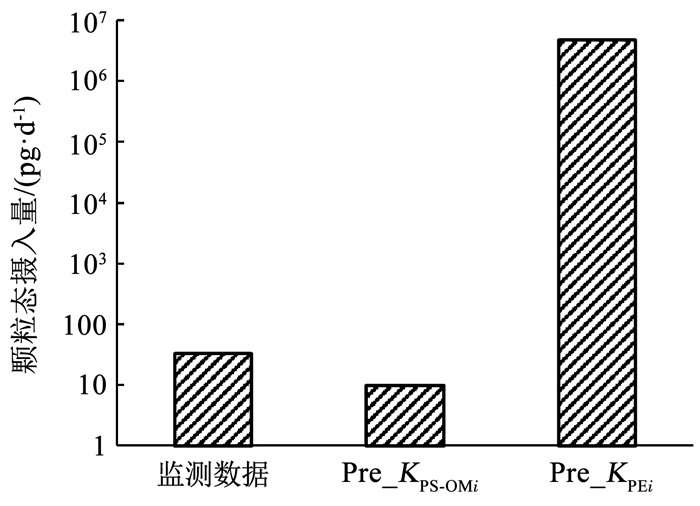
|
图 4 粒径影响下颗粒态PBDEs经皮肤每日摄入量的预测结果与哈尔滨监测结果对比 Fig. 4 Comparison between predicting and monitoring results of daily dermal intakes of PBDEs in Harbin |
Su等[11]测量了上海大气环境中6个粒径区间(< 0.4、0.4~1.1、1.1~2.1、2.1~5.8、5.8~9和>9 μm)9种颗粒态和气态PBDEs(BDE-17、BDE-28、BDE-47、BDE-85、BDE-99、BDE-100、BDE-153、BDE-154和BDE-183)的质量浓度以及MPi。利用式(8)以及恒稳态和平衡态多粒径气/粒分配公式,由9种气态PBDEs的检测数据,预测了上海大气环境中颗粒态PBDEs经皮肤每日摄入量,并且根据Su等研究中的监测数据,评估了其实际大气环境中颗粒态PBDEs经皮肤每日摄入量。如图 5所示,上海大气环境中9种颗粒态PBDEs经皮肤每日摄入量为72.2 pg/d(监测数据),KPS-OMi很好地预测了上海大气环境中颗粒态PBDEs经皮肤每日摄入量(103 pg/d),KPEi预测的上海颗粒态PBDEs经皮肤每日摄入量为1 710 pg/d,高于实际监测值一个数量级以上。
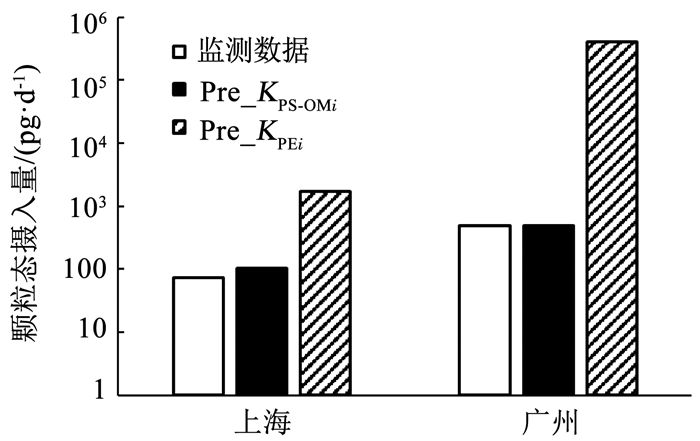
|
图 5 粒径影响下颗粒态PBDEs经皮肤每日摄入量的预测结果与上海、广州监测结果对比 Fig. 5 Comparison between predicting and monitoring results of daily dermal intakes of PBDEs in Guangzhou and Shanghai |
Zhang等[26]报道了广州距离地面50和150 m大气环境11个粒径区间(与哈尔滨颗粒物粒径区间相同)5种颗粒态和气态PBDEs(BDE-47、BDE-99、BDE-183、BDE-207和BDE-209)质量浓度。由于没有MPi数据,假设TSP质量浓度为100 μg/m3,广州大气中MPi由哈尔滨大气中各粒径区间MPi占TSP百分比估算得来;同样,由于缺乏BDE-207的相关参数,无法估算其皮肤摄入量,故只讨论其余4种PBDEs经皮肤摄入量。应用KPS-OMi和KPEi于式(8),由4种气态PBDEs监测质量浓度预测的广州颗粒态PBDEs经皮肤每日摄入量分别为49和0.412 μg/d。广州大气颗粒物4种PBDEs经皮肤每日摄入量的监测值为481 pg/d,与KPS-OMi预测的PBDEs经皮肤摄入量基本一致,远低于KPEi预测的摄入量,说明KPS-OMi很好地应用于预测广州大气环境中颗粒态PBDEs的经皮肤摄入量。
值得注意的是,平衡态公式KPEi是通过将全颗粒态(TSP)的平衡态气粒分配公式(KPE)中颗粒物的fOM改变为对应粒径区间颗粒物的fOMi得到的。而恒稳态公式(KPSi)是通过理论推导并结合颗粒物和PBDEs的粒径分布与fOMi的关系,获取各粒径区间KPSi与全颗粒态恒稳态公式(KPS)的偏离量得到的。此外,平衡态理论的发现过程是在实验室条件下,没有考虑实际环境中各因素的影响, 而恒稳态理论充分考虑了实际环境中颗粒态PBDEs和气态PBDEs的环境行为,这很可能是恒稳态(KPSi)预测结果更接近于实际摄入量的一个重要原因。
2.6 不确定性分析与环境意义本研究给出了基于多粒径气/粒分配的预测粒径影响下颗粒态PBDEs经皮肤摄入量的方法和公式。利用恒稳态多粒径气/粒分配公式与摄入量预测公式相结合,很好地预测哈尔滨、上海和广州的监测数据,预测摄入量与监测值得到的摄入量非常接近,差异远低于预测误差允许的范围。式(1)和(2)中,本研究使用的参数为长期暴露参数,对于特殊群体和特定环境,计算结果可能存在差异。然而,差异不可避免,本研究的目的是尝试确定一种可预测粒径影响下颗粒态PBDEs经皮肤摄入量的方法,并尽可能推广应用。从事人体健康暴露研究的学者们可以在接下来对特定人群或环境的研究中使用更合适的参数来计算。
从事健康风险评估工作的学者可以仅从气态质量浓度、颗粒物质量浓度和有机质质量分数(颗粒物质量浓度和有机质质量分数可以是经验值),直接评估粒径影响下颗粒态PBDEs的人体经皮肤摄入量,大大节省了获取不同粒径区间颗粒态污染物质量浓度所消耗的巨大人力和财力。值得注意的是,本研究首次预测了粒径影响下颗粒态PBDEs经皮肤摄入量,弥补了目前健康风险评估严重依赖监测数据的不足,对健康风险评估工作有重要推动作用。
3 结论1) 监测数据表明,哈尔滨全年大气环境中PBDEs的人体经皮肤每日摄入量为71.6 pg/d,BDE-209为人体经皮肤摄入的主要物质,占8种PBDEs摄入量的91.3%,颗粒态PBDEs经皮肤每日摄入量略小于气态PBDEs,且颗粒态PBDEs摄入量占比随PBDEs相对分子质量增大而增大。
2) 受PBDEs气/粒分配和PBDEs污染源影响,供暖期PBDEs人体经皮肤每日摄入量大于非供暖期。受传质系数影响,颗粒态PBDEs人体经皮肤摄入量由大于3.2 μm颗粒物主导。
3) 利用气粒分配理论与皮肤摄入量计算公式相结合,给出了可预测粒径影响下颗粒态PBDEs摄入量的公式,利用哈尔滨、上海和广州不同种类PBDEs在划分的不同粒径区间内的监测数据,证明了恒稳态气粒分配理论较好地应用于本研究提出的预测粒径影响下颗粒态PBDEs摄入量的公式,准确地预测了粒径影响下颗粒态PBDEs人体经皮肤摄入量。
| [1] |
李文龙. 亚洲五国土壤和大气中溴代阻燃剂的时空分布和健康风险[D]. 哈尔滨: 哈尔滨工业大学, 2016 LI Wenlong. Spatiotemporal variations and human health risks of brominated flame retardants in soils and air of five Aisan countries[D]. Harbin: Harbin Institute of Technology, 2016 |
| [2] |
李圆圆. 东海持久性有机污染物多溴联苯醚的"源—汇"作用研究[D]. 上海: 复旦大学, 2014 LI Yuanyuan. From source to sink of polybrominated diphenyl ethers, one group of persistent organic pollutants in the East China Sea[D]. Shanghai: Fudan University, 2014 |
| [3] |
YANG Meng, QI Hong, JIA Hongliang, et al. Polybrominated diphenyl ethers in air across China: levels, compositions, and gas-particle partitioning[J]. Environmental Science & Technology, 2013, 47(15): 8978. DOI:10.1021/es4022409 |
| [4] |
LI Yifan, QIAO Lina, REN Nanqi, et al. Decabrominated diphenyl ethers (BDE-209) in Chinese and global air: levels, gas/particle partitioning, and long-range transport is long-range transport of BDE-209 really governed by the movement of particles?[J]. Environmental Science & Technology, 2017, 51(2): 1035. DOI:10.1021/acs.est.6b05395 |
| [5] |
白春蕾, 解春宵, 李科. 室内环境中多溴联苯醚的污染特征和暴露风险研究进展[J]. 环境化学, 2019, 38(12): 2736. BAI Chunlei, XIE Chunxiao, LI Ke. The pollution characteristics and exposure risk of polybrominated diphenyl ethers (PBDEs) in indoor environment[J]. Environmental Chemistry, 2019, 38(12): 2736. DOI:10.7524/j.issn.0254-6108.2019072802 |
| [6] |
HU Yuanjie, BAO Lianjun, HUANG Chunli, et al. A comprehensive risk assessment of human inhalation exposure to atmospheric halogenated flame retardants and organophosphate esters in an urban zone[J]. Environmental Pollution, 2019, 252: 1902. DOI:10.1016/j.envpol.2019.06.010 |
| [7] |
刘锋平, 朱英. 室内环境中多溴联苯醚污染及人体暴露研究进展[J]. 卫生研究, 2018, 47(2): 335. LIU Fengping, ZHU Ying. Research progress on contamination of polybrominated diphenyl ethers in indoor environment and human exposure[J]. Journal of Hygiene Research, 2018, 47(2): 335. DOI:10.7524/j.issn.0254-6108.2019072802 |
| [8] |
LUO Pei, NI Hongang, BAO Lianjun, et al. Size distribution of airborne particle-bound polybrominated diphenyl ethers and its implications for dry and wet deposition[J]. Environmental Science & Technology, 2014, 48(23): 13793. DOI:10.1021/es5042018 |
| [9] |
BESIS A, BOTSAROPOULOU E, VOUTSA D, et al. Particle-size distribution of polybrominated diphenyl ethers (PBDEs) in the urban agglomeration of Thessaloniki, northern Greece[J]. Atmospheric Environment, 2015, 104: 176. DOI:10.1016/j.atmosenv.2015.01.019 |
| [10] |
CAO Zhiguo, ZHAO Leicheng, MENG Xuejie, et al. Amplification effect of haze on human exposure to halogenated flame retardants in atmospheric particulate matter and the corresponding mechanism[J]. Journal of Hazardous Materials, 2018, 359: 491. DOI:10.1016/j.jhazmat.2018.07.109 |
| [11] |
SU Penghao, TOMY G T, HOU Chunyan, et al. Gas/particle partitioning, particle-size distribution of atmospheric polybrominated diphenyl ethers in southeast Shanghai rural area and size-resolved predicting model[J]. Chemosphere, 2018, 197: 251. DOI:10.1016/j.chemosphere.2018.01.005 |
| [12] |
HU Pengtuan, SU Penghao, MA Wanli, et al. New equation to predict size-resolved gas-particle partitioning quotients for polybrominated diphenyl ethers[J]. Journal of Hazardous Materials, 2020, 400: 123245. DOI:10.1016/j.jhazmat.2020.123245 |
| [13] |
WESCHLER C J, NAZAROFF W W. SVOC exposure indoors: fresh look at dermal pathways[J]. Indoor Air, 2012, 22(5): 356. DOI:10.1111/j.1600-0668.2012.00772.x |
| [14] |
LAO Jiayong, XIE Shanyi, WU Chenchou, et al. Importance of dermal absorption of polycyclic aromatic hydrocarbons derived from barbecue fumes[J]. Environmental Science & Technology, 2018, 52(15): 8330. DOI:10.1021/acs.est.8b01689 |
| [15] |
中华人民共和国生态环境部. 中国人群暴露参数手册(成人卷)[M]. 北京: 中国环境出版社, 2013: 766. Ministry of Ecology and Enviornmental of the People's Republic of China. Exposure factors handbook of Chinese polulation[M]. Beijing: China Environmental Science Press, 2013: 766. |
| [16] |
WESCHLER C J, NAZAROFF W W. Dermal uptake of organic vapors commonly found in indoor air[J]. Environmental Science & Technology, 2014, 48(2): 1230. DOI:10.1021/es405490a |
| [17] |
VENKATARAMAN C, THOMAS S, KULKARNI P. Size distributions of polycyclic aromatic hydrocarbons: gas/particle partitioning to urban aerosols[J]. Journal of Aerosol Science, 1999, 30(6): 759. DOI:10.1016/s0021-8502(98)00761-7 |
| [18] |
LV Yan, XU Tingting, LI Xiang, et al. Size distribution of particle-associated polybrominated diphenyl ethers (PBDEs) and their implications for health[J]. Atmospheric Measurement Techniques, 2016, 9(3): 1025. DOI:10.5194/amt-9-1025-2016 |
| [19] |
LI Yifan, MA Wanli, YANG Meng. Prediction of gas/particle partitioning of polybrominated diphenyl ethers (PBDEs) in global air: a theoretical study[J]. Atmospheric Chemistry and Physics, 2015, 15(4): 1669. DOI:10.5194/acp-15-1669-2015 |
| [20] |
YANG Meng, LI Yifan, QIAO Lina, et al. Estimating subcooled liquid vapor pressures and octanol-air partition coefficients of polybrominated diphenyl ethers and their temperature dependence[J]. Science of the Total Environment, 2018, 628/629: 329. DOI:10.1016/j.scitotenv.2018.02.054 |
| [21] |
CAO Zhiguo, ZHAO Leicheng, ZHANG Yacai, et al. Influence of air pollution on inhalation and dermal exposure of human to organophosphate flame retardants: a case study during a prolonged haze episode[J]. Environmental Science & Technology, 2019, 53(7): 3880. DOI:10.1021/acs.est.8b07053 |
| [22] |
BJORKLUND J A, THURESSON K, COUSINS A P, et al. Indoor air is a significant source of tri-decabrominated diphenyl ethers to outdoor air via ventilation systems[J]. Environmental Science & Technology, 2012, 46(11): 5876. DOI:10.1021/es204122v |
| [23] |
WONG F, DE WIT C A, NEWTON S R. Concentrations and variability of organophosphate esters, halogenated flame retardants, and polybrominated diphenyl ethers in indoor and outdoor air in Stockholm, Sweden[J]. Environmental Polluttion, 2018, 240: 514. DOI:10.1016/j.envpol.2018.04.086 |
| [24] |
HARNER T, BIDLEMAN T F. Octanol-air partition coefficient for describing particle/gas partitioning of aromatic compounds in urban air[J]. Environmental Science and Technology, 1998, 32(10): 1494. DOI:10.1021/es970890r |
| [25] |
SHI Shanshan, ZHAO Bin. Deposition of indoor airborne particles onto human body surfaces: a modeling analysis and manikin-based experimental study[J]. Aerosol Science and Technology, 2013, 47(12): 1363. DOI:10.1080/02786826.2013.843772 |
| [26] |
ZHANG Baozhong, ZHANG Kai, LI Shaomeng, et al. Size-dependent dry deposition of airborne polybrominated diphenyl ethers in urban Guangzhou, China[J]. Environmental Science & Technology, 2012, 46(13): 7207. DOI:10.1021/es300944a |
 2022, Vol. 54
2022, Vol. 54


